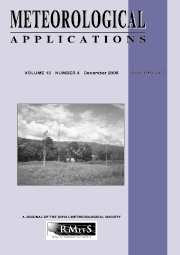Crossref Citations
This article has been cited by the following publications. This list is generated based on data provided by
Crossref.
Chapman, Lee
Thornes, John E
and
Bradley, Andrew V
2001.
Modelling of road surface temperature from a geographical parameter database. Part 1: Statistical.
Meteorological Applications,
Vol. 8,
Issue. 4,
p.
409.
Postgård, U
2001.
Adjustment time for road surface temperature during weather changes.
Meteorological Applications,
Vol. 8,
Issue. 4,
p.
397.
Chapman, Lee
Thornes, John E
and
Bradley, Andrew V
2001.
Modelling of road surface temperature from a geographical parameter database. Part 2: Numerical.
Meteorological Applications,
Vol. 8,
Issue. 4,
p.
421.
Gustavsson, Torbjörn
Bogren, Jörgen
and
Green, Cecilia
2001.
Road Climate in Cities:A Study of the Stockholm Area, South‐East Sweden.
Meteorological Applications,
Vol. 8,
Issue. 4,
p.
481.
Eriksson, M
and
Norrman, J
2001.
Analysis of station locations in a road weather information system.
Meteorological Applications,
Vol. 8,
Issue. 4,
p.
437.
Postgård, U
and
Lindqvist, S
2001.
Air and road surface temperature variations during weather change.
Meteorological Applications,
Vol. 8,
Issue. 1,
p.
71.
Lindberg, Fredrik
Holmer, Björn
and
Thorsson, Sofia
2008.
SOLWEIG 1.0 – Modelling spatial variations of 3D radiant fluxes and mean radiant temperature in complex urban settings.
International Journal of Biometeorology,
Vol. 52,
Issue. 7,
p.
697.
Nordin, Lina
Gustavsson, Torbjörn
Bogren, Jörgen
Chen, Deliang
Li, Haisheng
and
Tian, Hua
2009.
ChiWI—a road weather index for China.
International Journal of Climatology,
Vol. 29,
Issue. 15,
p.
2337.
Hammond, D. S.
Chapman, L.
and
Thornes, J. E.
2010.
Verification of route-based road weather forecasts.
Theoretical and Applied Climatology,
Vol. 100,
Issue. 3-4,
p.
371.
Karsisto, Virve
Nurmi, Pertti
Kangas, Markku
Hippi, Marjo
Fortelius, Carl
Niemelä, Sami
and
Järvinen, Heikki
2016.
Improving road weather model forecasts by adjusting the radiation input.
Meteorological Applications,
Vol. 23,
Issue. 3,
p.
503.
Lindberg, Fredrik
Onomura, Shiho
and
Grimmond, C. S. B.
2016.
Influence of ground surface characteristics on the mean radiant temperature in urban areas.
International Journal of Biometeorology,
Vol. 60,
Issue. 9,
p.
1439.
An, Seung Man
Son, Hak-gi
Lee, Kyoo-Seock
and
Yi, Chaeyeon
2016.
A Study of the Urban Tree Canopy Mean Radiant Temperature Mitigation Estimation.
Journal of the Korean Institute of Landscape Architecture,
Vol. 44,
Issue. 1,
p.
93.
Hu, Yumei
Almkvist, Esben
Lindberg, Fredrik
Bogren, Jörgen
and
Gustavsson, Torbjörn
2016.
The use of screening effects in modelling route-based daytime road surface temperature.
Theoretical and Applied Climatology,
Vol. 125,
Issue. 1-2,
p.
303.
Karsisto, Virve
Tijm, Sander
and
Nurmi, Pertti
2017.
Comparing the Performance of Two Road Weather Models in the Netherlands.
Weather and Forecasting,
Vol. 32,
Issue. 3,
p.
991.
Burud, Ingunn
Vukovic, Marija
Thiis, Thomas K.
Gaitani, Niki
Themistocleous, Kyriacos
Hadjimitsis, Diofantos G.
Michaelides, Silas
Ambrosia, Vincent
and
Papadavid, Giorgos
2018.
Urban surfaces studied by VIS/NIR imaging from UAV: possibilities and limitations.
p.
39.
Meng, Chunlei
2018.
Reference Module in Earth Systems and Environmental Sciences.
Karsisto, Virve
and
Lovén, Lauri
2019.
Verification of Road Surface Temperature Forecasts Assimilating Data from Mobile Sensors.
Weather and Forecasting,
Vol. 34,
Issue. 3,
p.
539.
Hu, Yumei
Almkvist, Esben
Gustavsson, Torbjörn
and
Bogren, Jörgen
2019.
Modeling Road Surface Temperature from Air Temperature and Geographical Parameters—Implication for the Application of Floating Car Data in a Road Weather Forecast Model.
Journal of Applied Meteorology and Climatology,
Vol. 58,
Issue. 5,
p.
1023.
Yin, Zhicong
Hadzimustafic, Jasmina
Kann, Alexander
and
Wang, Yong
2019.
On statistical nowcasting of road surface temperature.
Meteorological Applications,
Vol. 26,
Issue. 1,
p.
1.
Oswald, Sandro M.
Revesz, Michael
Trimmel, Heidelinde
Weihs, Philipp
Zamini, Shokufeh
Schneider, Astrid
Peyerl, Martin
Krispel, Stefan
Rieder, Harald E.
Mursch-Radlgruber, Erich
and
Lindberg, Fredrik
2019.
Coupling of urban energy balance model with 3-D radiation model to derive human thermal (dis)comfort.
International Journal of Biometeorology,
Vol. 63,
Issue. 6,
p.
711.

